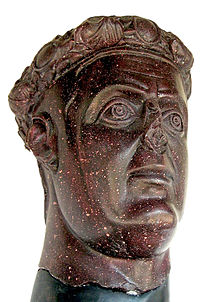
Back غاليريوس Arabic جاليريوس ARZ Qaleri Azerbaijani قالریوس AZB Галерый Byelorussian Галерий Bulgarian Galerius Breton Galeri Catalan Galerius Czech Galerius Welsh
| Galerius | |||||||||
|---|---|---|---|---|---|---|---|---|---|
 | |||||||||
| Roman emperor | |||||||||
| Augustus | 1 May 305 – early May 311 | ||||||||
| Predecessor | Diocletian and Maximian | ||||||||
| Successor | Maximinus II and Licinius (both in the East) | ||||||||
| Co-rulers | See list
| ||||||||
| Caesar | 1 March 293[i] – 1 May 305 (under Diocletian)[2] | ||||||||
| Born | Galerius Maximinus[3][4] c. 258[5][6] Felix Romuliana, Roman Dacia, Roman Empire[6] | ||||||||
| Died | early May 311[7] (aged c. 53) Serdica, Dacia Ripensis, Roman Empire | ||||||||
| Burial | |||||||||
| Spouse | Galeria Valeria[8] | ||||||||
| Issue | |||||||||
| |||||||||
| Father | Diocletian (adoptive) | ||||||||
| Mother | Romula (alleged)[9] | ||||||||
| Religion | Roman polytheism | ||||||||
Galerius Valerius Maximianus[j] (/ɡəˈlɛəriəs/; Greek: Γαλέριος; c. 258 – May 311) was Roman emperor from 305 to 311. During his reign he campaigned, aided by Diocletian, against the Sasanian Empire, sacking their capital Ctesiphon in 299. He also campaigned across the Danube against the Carpi, defeating them in 297 and 300. Although he was a staunch opponent of Christianity, Galerius ended the Diocletianic Persecution when he issued the Edict of Toleration in Serdica (Sofia) in 311.
- ^ Elsner, Jas (2018). The Art of the Roman Empire AD 100-450. Oxford University Press. p. 58. ISBN 9780198768630.
A recently discovered porphyry head of a tetrarch from Romuliana in modern Serbia —the birth and burial place of Galerius (293–311) [...] It is likely that the statue portrays Galerius as Caesar after his victory over the Persians in AD 297/8.
- ^ a b Barnes 1982, p. 4.
- ^ Lactantius, de Mortibus Persecutorum, 18. "Now Galerius had lately bestowed part of his own name on that youth [Daia], and called him Maximin, in like manner as Diocletian formerly bestowed on Galerius the name of Maximian".
- ^ For an analysis of the official nomenclature of the Tetrarchs, see Salway, Benet (1994). "What's in a Name? A Survey of Roman Onomastic Practice from c. 700 B.C. to A.D. 700" (PDF). Journal of Roman Studies. 84: 137–140. doi:10.2307/300873. JSTOR 300873. S2CID 162435434.
- ^ Leadbetter, pp. 18–21.
- ^ a b c Barnes 1982, p. 37.
- ^ Lactantius, DMP 35.4. "This edict was promulgated at Nicomedia on the day preceding the kalends of May [30 April]... In a few days after he was consumed by the horrible disease that had brought on an universal putrefaction [...] This event was known at Nicomedia before the end of the month.".
- ^ Barnes 1982, p. 38.
- ^ Barnes 1982, p. 37–38.
- ^ Sandys, John (1927). Latin Epigraphy: An Introduction to the Study of Latin Inscriptions. Cambridge University Press. p. 232.
- ^ Maxwelll, Craven (2019). The Imperial Families of Ancient Rome. Fonthill Media. p. 414.
Cite error: There are <ref group=lower-alpha> tags or {{efn}} templates on this page, but the references will not show without a {{reflist|group=lower-alpha}} template or {{notelist}} template (see the help page).
© MMXXIII Rich X Search. We shall prevail. All rights reserved. Rich X Search